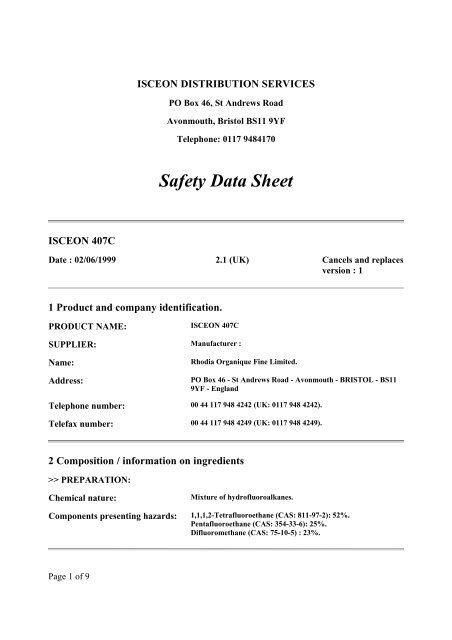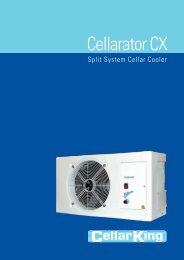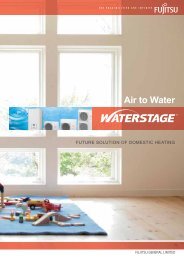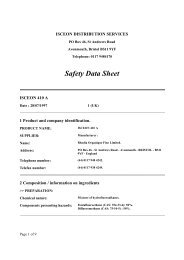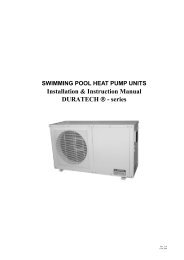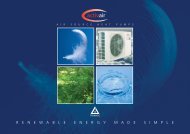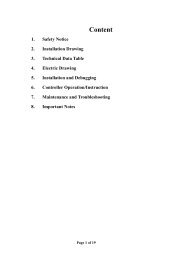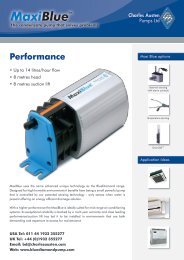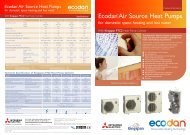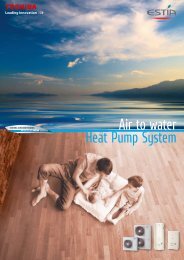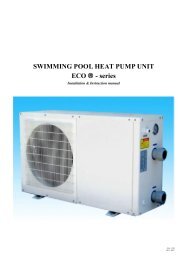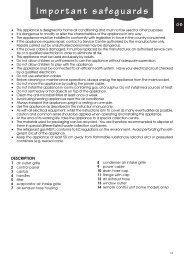to download the R407c material safety data sheet
to download the R407c material safety data sheet
to download the R407c material safety data sheet
You also want an ePaper? Increase the reach of your titles
YUMPU automatically turns print PDFs into web optimized ePapers that Google loves.
ISCEON DISTRIBUTION SERVICES<br />
PO Box 46, St Andrews Road<br />
Avonmouth, Bris<strong>to</strong>l BS11 9YF<br />
Telephone: 0117 9484170<br />
Safety Data Sheet<br />
ISCEON 407C<br />
Date : 02/06/1999 2.1 (UK) Cancels and replaces<br />
version : 1<br />
1 Product and company identification.<br />
PRODUCT NAME:<br />
ISCEON 407C<br />
SUPPLIER: Manufacturer :<br />
Name:<br />
Address:<br />
Rhodia Organique Fine Limited.<br />
PO Box 46 - St Andrews Road - Avonmouth - BRISTOL - BS11<br />
9YF - England<br />
Telephone number: 00 44 117 948 4242 (UK: 0117 948 4242).<br />
Telefax number: 00 44 117 948 4249 (UK: 0117 948 4249).<br />
2 Composition / information on ingredients<br />
>> PREPARATION:<br />
Chemical nature:<br />
Mixture of hydrofluoroalkanes.<br />
Components presenting hazards: 1,1,1,2-Tetrafluoroethane (CAS: 811-97-2): 52%.<br />
Pentafluoroethane (CAS: 354-33-6): 25%.<br />
Difluoromethane (CAS: 75-10-5) : 23%.<br />
Page 1 of 9
3 Hazards identification<br />
MOST IMPORTANT HAZARDS:<br />
Adverse human health effects:<br />
Main symp<strong>to</strong>ms:<br />
Physical and chemical hazards:<br />
Classification/Specific hazards:<br />
Contains a liquefied gas. Contact of liquid may cause frostbite<br />
and injury <strong>to</strong> <strong>the</strong> cornea.<br />
May have a narcotic effect at high concentrations.<br />
Heating will cause a rise in pressure with a risk of bursting.<br />
On combustion, <strong>to</strong>xic gases are released.<br />
According <strong>to</strong> EEC criteria, this product is not classified as a<br />
"hazardous preparation".<br />
4 First-aid measures<br />
Inhalation:<br />
Skin contact:<br />
Eye contact:<br />
Ingestion:<br />
Notes <strong>to</strong> <strong>the</strong> physician:<br />
Move <strong>the</strong> affected person away from <strong>the</strong> contaminated area and<br />
in<strong>to</strong> <strong>the</strong> fresh air.<br />
Make <strong>the</strong> affected person rest.<br />
If breathing s<strong>to</strong>ps, give artificial respiration.<br />
Call a doc<strong>to</strong>r immediately.<br />
Contact of liquid with <strong>the</strong> skin:<br />
First rinse with plenty of water. Remove contaminated clothing<br />
and <strong>the</strong>n rinse again with water.<br />
If it sticks, do not pull it off.<br />
Call a doc<strong>to</strong>r immediately.<br />
Contact of liquid with <strong>the</strong> eyes:<br />
Rinse with water whilst keeping <strong>the</strong> eyes wide open.<br />
Consult an eye specialist immediately.<br />
Not specifically applicable (gas).<br />
Avoid administering adrenaline or any o<strong>the</strong>r similar products.<br />
5 Fire - fighting measures<br />
Extinguishing media:<br />
- Suitable: All extinguishing agents can be used.<br />
- Not suitable: None. If <strong>the</strong>re is a fire close by, use suitable extinguishing agents.<br />
Specific hazards:<br />
Specific fire fighting methods:<br />
Page 2 of 9<br />
Pressurized container. On heating <strong>the</strong>re is a risk of bursting due<br />
<strong>to</strong> internal pressure build-up.<br />
NOT flammable. However, it may present a risk in <strong>the</strong> event of a<br />
fire.<br />
Toxic vapours (halogen compounds) are released.<br />
Stay upwind.<br />
Evacuate <strong>the</strong> personnel away from <strong>the</strong> fumes.<br />
Cool down <strong>the</strong> containers/equipment exposed <strong>to</strong> heat with a
water spray.<br />
Protection of fire-fighters:<br />
Self-contained breathing apparatus.<br />
6 Accidental release measures<br />
Personal precautions:<br />
Environmental precautions:<br />
Avoid contact with skin and eyes.<br />
Do not brea<strong>the</strong> gas.<br />
NO naked flames.<br />
Do NOT smoke.<br />
For fur<strong>the</strong>r information refer <strong>to</strong> section 8 "Exposurecontrols/personal<br />
protection".<br />
Heavy vapours. Shut off low-level openings in <strong>the</strong> vicinity<br />
(ventilation shafts, drains...).<br />
Prevent <strong>the</strong> product from entering cellars, basements or pits.<br />
S<strong>to</strong>p <strong>the</strong> leak.<br />
Ventilate spillage area.<br />
Ventilate basements.<br />
Prevent <strong>the</strong> product from spreading in<strong>to</strong> <strong>the</strong> environment.<br />
Contain <strong>the</strong> spilled <strong>material</strong> by bunding.<br />
Methods for cleaning up:<br />
- Recovery: Recover as much of <strong>the</strong> product as possible.<br />
- Cleaning/Decontamination: Allow residual product <strong>to</strong> evaporate.<br />
- Disposal: For disposal of contaminated <strong>material</strong>s refer <strong>to</strong> section 13:<br />
"Disposal considerations".<br />
7 Handling and s<strong>to</strong>rage<br />
HANDLING<br />
Technical measures:<br />
Measures:<br />
Ventilation.<br />
Use in a closed system.<br />
Avoid contact with hot surfaces.<br />
Avoid high temperatures.<br />
Smoking is forbidden.<br />
STORAGE<br />
Technical measures:<br />
S<strong>to</strong>rage facilities should be:<br />
equipped with ventilation at low level.<br />
Take all necessary precautions <strong>to</strong> avoid <strong>the</strong> accidental release of<br />
<strong>the</strong> product outside, due <strong>to</strong> <strong>the</strong> rupture of containers or transfer<br />
systems.<br />
S<strong>to</strong>rage conditions:<br />
- Recommended: Keep:<br />
- <strong>the</strong> container tightly closed and dry.<br />
Page 3 of 9
- in a cool, well-ventilated area.<br />
- at temperatures not exceeding 30°C.<br />
- away from any source of heat.<br />
- away from any source of ignition.<br />
Incompatible products: Refer <strong>to</strong> <strong>the</strong> detailed list of incompatible <strong>material</strong>s (section 10<br />
"Stability/Reactivity").<br />
Packaging:<br />
Pressurized metal container.<br />
Packaging <strong>material</strong>s:<br />
- Recommended: Steel.<br />
- Not suitable: Magnesium and its alloys.<br />
Zinc and its alloys.<br />
Aluminium alloys containing more than 2% magnesium.<br />
8 Exposure controls / personal protection<br />
Engineering measures:<br />
Ensure good ventilation of <strong>the</strong> work station.<br />
Control parameters:<br />
Occupational exposure limits:<br />
- Limits (UK): Tetrafluoroethane :<br />
OES: 1000 ppm (4200 mg/m3). (Long term exposure limit - 8h<br />
TWA reference period).<br />
Personal protective equipment:<br />
- Respira<strong>to</strong>ry protection: In <strong>the</strong> event of insufficient ventilation:<br />
Self-contained breathing apparatus.<br />
- Hand protection: Handling refrigerated product:<br />
Protective gloves insulated against <strong>the</strong> cold.<br />
- Eye protection: Handling refrigerated product:<br />
Goggles.<br />
- Skin and body protection: Handling refrigerated product:<br />
Impermeable clothing.<br />
Hygiene measures:<br />
Do NOT drink, eat or smoke in <strong>the</strong> workplace.<br />
9 Physical and chemical properties<br />
APPEARANCE:<br />
- Physical state: Compressed liquefied gas.<br />
- Colour: colourless.<br />
Page 4 of 9
Odour:<br />
pH:<br />
slightly e<strong>the</strong>real.<br />
Not applicable<br />
Specific temperatures:<br />
- Boiling: Boiling range : -44.3 - -37.1°C.<br />
Flammability characteristics:<br />
- Flash point: Not applicable.<br />
Oxidizing properties:<br />
Vapour pressure:<br />
Specific gravity:<br />
Non oxidizing <strong>material</strong> according <strong>to</strong> EEC criteria.<br />
1041 kPa, at 20°C.<br />
1160 kg/m3, at 20°C.<br />
Solubility:<br />
- in water: Slightly soluble.<br />
- in organic solvents: Soluble in:<br />
- common solvents.<br />
10 Stability and reactivity.<br />
Stability:<br />
Stable at ambient temperature and under normal conditions of<br />
use.<br />
Hazardous reactions:<br />
- Conditions <strong>to</strong> avoid: May decompose:<br />
- on contact with hot surfaces and flames.<br />
- Materials <strong>to</strong> avoid: Reacts violently with:<br />
- alkali metals.<br />
- alkaline earth metals.<br />
- magnesium.<br />
- powdered metals.<br />
- Hazardous decomposition<br />
products:<br />
On combustion or on <strong>the</strong>rmal decomposition (pyrolysis) releases:<br />
<strong>to</strong>xic gases.<br />
(Fluorinated compounds).<br />
(Hydrofluoric acid).<br />
11 Toxicological information<br />
Acute <strong>to</strong>xicity:<br />
1,1,1,2-Tetrafluoroethane:<br />
LC 50 inhalation (Rat): 4h: > 2254 mg/l.<br />
Pentafluoroethane:<br />
LC 50 inhalation (Rat) / 4 h : > 3928 mg/l.<br />
For Difluoromethane :<br />
Page 5 of 9
LC 50 inhalation (Rat) / 4h: >1064 mg/l.<br />
(Unpublished work).<br />
Acute symp<strong>to</strong>ms:<br />
Local effects:<br />
Fur<strong>the</strong>r information:<br />
Effects following high level exposure:<br />
Headaches.<br />
Dizziness.<br />
Loss of consciousness.<br />
Possible effects, following high level exposure:<br />
Cardiac disorders.<br />
Possibility of cardiac arrest.<br />
Contact with liquefied gas causes frostbite.<br />
Contact with liquefied gas causes injury <strong>to</strong> <strong>the</strong> cornea.<br />
Not classified as hazardous according <strong>to</strong> EEC criteria.<br />
12 Ecological information<br />
Behaviour in <strong>the</strong> environment:<br />
Mobility:<br />
Persistence/Degradability:<br />
Bioaccumulation:<br />
Destination of <strong>the</strong> product:<br />
Product is volatile when in aqueous solution.<br />
No information available.<br />
No information available.<br />
Ultimate destination of <strong>the</strong> product : AIR.<br />
Eco<strong>to</strong>xicity:<br />
- Effects on <strong>the</strong> aquatic<br />
environment:<br />
No information available.<br />
13 Disposal considerations<br />
WASTE FROM RESIDUES:<br />
Prohibition:<br />
Destruction/Disposal:<br />
Do not allow <strong>the</strong> product <strong>to</strong> be released in<strong>to</strong> <strong>the</strong> environment.<br />
Consult <strong>the</strong> manufacturer or supplier for information regarding<br />
recovery and recycling of <strong>the</strong> product.<br />
If recovery is not possible:<br />
Incinerate at a licensed installation.<br />
CONTAMINATED PACKAGING:<br />
Decontamination/cleaning:<br />
Destruction/Disposal:<br />
De-gas.<br />
Re-usable containers:<br />
Return <strong>to</strong> <strong>the</strong> supplier.<br />
Disposable containers:<br />
Dispose of at an authorised land-fill site.<br />
Page 6 of 9
NOTE:<br />
The user's attention is drawn <strong>to</strong> <strong>the</strong> possible existence of local<br />
regulations regarding disposal.<br />
14 Transport information (*)<br />
INTERNATIONAL REGULATIONS :<br />
Land:<br />
- Rail/road (RID/ADR): UN number: 3340.<br />
Class:2.<br />
Item number : 2°A). (*)<br />
Hazard identification number: 20.<br />
Labelling: 2.<br />
Sea (IMO/IMDG): UN Number: 3340.<br />
Class: 2.2.<br />
Labelling: 2 GAZ COMPRIME ININFLAMMABLE.<br />
Marine pollutant: NO.<br />
Air (ICAO-IATA): UN number: 3340.<br />
Class: 2.2.<br />
Labelling: 2 NON-FLAMMABLE GAS.<br />
Cargo aircraft : Packing instruction: 200 Quantity : 150 kg.<br />
Passenger aircraft: Packing instruction: 200 Quantity : 75 kg.<br />
- United Kingdom: Rail/road Substance identification number: 3340.<br />
Classification for conveyance: Non-flammable compressed gas.<br />
Emergency action code: 2RE.<br />
NOTE:<br />
The above regula<strong>to</strong>ry prescriptions are those valid on <strong>the</strong> date of<br />
publication of this <strong>sheet</strong>.<br />
Given <strong>the</strong> possible evolution of transport regulations for<br />
hazardous <strong>material</strong>s, it would be advisable <strong>to</strong> check <strong>the</strong>ir validity<br />
with your sales office.<br />
15 Regula<strong>to</strong>ry information<br />
LABELLING :<br />
EEC regulations:<br />
Manda<strong>to</strong>ry labelling (self-classification) of hazardous substances:<br />
not applicable.<br />
- R phrases: No R phrases.<br />
- S phrases: S 24/25: Avoid contact with skin and eyes.<br />
S 41: In case of fire and/or explosion do not brea<strong>the</strong> fumes.<br />
NOTE:<br />
The regula<strong>to</strong>ry information given above only indicates <strong>the</strong><br />
principal regulations specifically applicable <strong>to</strong> <strong>the</strong> product<br />
described in <strong>the</strong> Safety Data Sheet.<br />
The user's attention is drawn <strong>to</strong> <strong>the</strong> possible existence of<br />
additional provisions which complete <strong>the</strong>se regulations.<br />
Refer <strong>to</strong> all applicable national, international and local<br />
Page 7 of 9
egulations or provisions.<br />
16 O<strong>the</strong>r information<br />
Uses:<br />
- Recommended uses: Refrigerant.<br />
Fur<strong>the</strong>r product information:<br />
Chemical formula: C2 H2 F4.<br />
C2 H F5.<br />
C H2 F2.<br />
Registration numbers:<br />
All <strong>the</strong> components of this preparation are registered in <strong>the</strong><br />
TSCA inven<strong>to</strong>ry.<br />
All <strong>the</strong> constituents of this preparation are registered in <strong>the</strong><br />
EINECS inven<strong>to</strong>ry.<br />
EINECS Nº: 212-377-0<br />
EINECS N°: 206-557-8.<br />
EINECS Nº: 200-839-4<br />
This <strong>safety</strong> <strong>data</strong> <strong>sheet</strong> should be used in conjunction with technical <strong>sheet</strong>s. It does not replace <strong>the</strong>m. The<br />
information given is based on our knowledge of this product, at <strong>the</strong> time of publication. It is given in good<br />
faith.<br />
The attention of <strong>the</strong> user is drawn <strong>to</strong> <strong>the</strong> possible risks incurred by using <strong>the</strong> product for any o<strong>the</strong>r purpose<br />
o<strong>the</strong>r than that for which it was intended.<br />
This does not in any way excuse <strong>the</strong> user from knowing and applying all <strong>the</strong> regulations governing his<br />
activity. It is <strong>the</strong> sole responsibility of <strong>the</strong> user <strong>to</strong> take all precautions required in handling <strong>the</strong> product.<br />
The aim of <strong>the</strong> manda<strong>to</strong>ry regulations mentioned is <strong>to</strong> help <strong>the</strong> user <strong>to</strong> fulfil his obligations regarding <strong>the</strong> use<br />
of hazardous products.<br />
This information is not exhaustive.<br />
This does not exonerate <strong>the</strong> user from ensuring that legal obligations, o<strong>the</strong>r than those mentioned, relating <strong>to</strong><br />
<strong>the</strong> use and s<strong>to</strong>rage of <strong>the</strong> product, do not exist.This is solely his responsibility.<br />
Page 8 of 9


